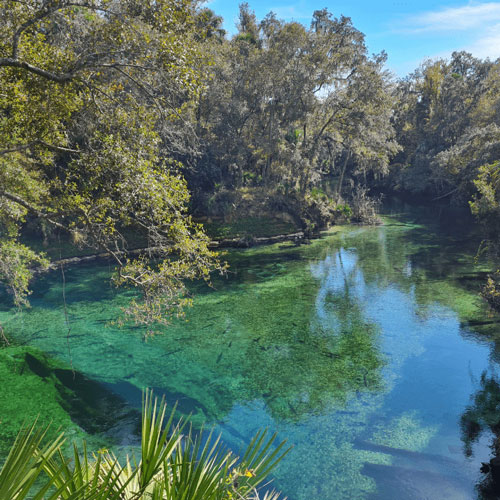Tragedy at Blue Springs State Park: Remembering Samuel Slack


| Incident Location | Diver Full Name |
|---|---|
| Blue Springs State Park, Florida, USA | Samuel Slack |
Dive into the captivating account of a thrilling diving expedition gone wrong in the alluring waters of Florida’s Blue Springs State Park. This story involves friendship, passion, unexpected challenges, and a tragic finale, unraveling the profound implications of diver preparedness and adherence to safety rules.
Blue Spring State Park: A Natural Wonder
Blue Spring State Park, located to the west of Orange City, Florida, in the United States, is a favorite among tourists, offering a variety of enjoyable activities. Visitors can partake in canoeing, scuba diving, kayaking, fishing, camping, hiking, observing wildlife, and swimming. The park’s prominent spring, known as Volusia Blue Spring, is the largest on the St. John’s River, maintaining a comfortable temperature of 73 degrees Fahrenheit, making it a winter haven for Florida manatees.
Dive Certification and Depth Restrictions
Approximately 102 million U.S. gallons of water pour out of Blue Spring into the St. John’s River daily, with an impressive depth of 120 feet. Only divers with official cave diving certification are permitted to explore such depths. Those with Open Water certification can venture up to 60 feet, marked by a cautionary sign at the cave’s entrance.
The Diving Buddies: Samuel and Daniel
Samuel Slack, a 36-year-old diving enthusiast from Edgewater, and Daniel Van Sickle, aged 37 from New Smyrna Beach, were close friends. Their friendship, nurtured at The Garlic Restaurant in New Smyrna Beach, where they both worked, led them to share a passion for diving. Samuel held an Open Water certification, allowing him to dive up to 60 feet, while Daniel had advanced certification as a cavern diver.
The Dive Plan and Safety Measures
Despite their differing levels of diving experience, Samuel and Daniel decided to embark on a diving expedition in Blue Spring. On October 9, 2013, they formally agreed to stick together and dive within the guidelines set by Florida State Park authorities. They committed to a maximum depth of 60 feet, a crucial restriction due to the challenging cave environment beyond this depth. Samuel and Daniel were fully equipped with diving gear, including diving tanks, diving masks, diving suits, and wrist-worn diving computers.
Unexpected Dive Deepening
During their dive, the initial stages went smoothly as they adhered to their agreed-upon depth limit of 60 feet. However, an unexpected turn of events occurred when they decided to venture further and dived to a depth of 116 feet.
The Critical Moment
At approximately 80 feet, Samuel began experiencing breathing difficulties, signaling his distress to Daniel with a throat slash sign. Daniel quickly passed his regulator to Samuel, offering a temporary solution to his breathing problem. However, due to the regulator’s placement beneath Daniel’s chest straps, it became inaccessible when needed. After about 30 seconds, Samuel held onto the regulator, prompting Daniel to swim away and take control of it.
The Desperate Call for Help
Daniel resurfaced and immediately called 9-1-1. Shortly before 3 pm, he returned to the water to find Samuel unresponsive at a depth of approximately 100 feet. Daniel inflated Samuel’s flotation device and carefully brought him to the water’s surface.
Efforts to Revive Samuel
Both Daniel and a Park employee attempted to revive Samuel on a designated platform for divers, but their efforts were unsuccessful. Fire rescue and Evac paramedics arrived on the scene and continued their life-saving efforts.
Samuel’s Tragic Outcome
Samuel was transported to Florida Hospital Fish Memorial, where his condition deteriorated, and he passed away shortly after 3:40 P.M.
Daniel’s Treatment for Decompression Sickness
Meanwhile, Daniel was transported to Florida Hospital Orlando to receive treatment in a specialized chamber designed for decompression sickness (DCS). This decision was due to Daniel’s failure to adhere to the necessary decompression stops during his ascent.
Decompression Sickness Explained
Decompression sickness occurs when a diver fails to undergo proper decompression after being exposed to increased pressure during scuba diving. Nitrogen bubbles can form in the blood, leading to joint and bone pains, known as “the bends.”
The Postmortem Report and Diving Tank Inspection
Samuel’s postmortem report did not reveal any noticeable injuries, and his passing was attributed to accidental drowning. An inspection of his diving tank showed that it contained enough air for him to surface easily. However, the valve on Samuel’s tank had been improperly turned, hindering proper airflow.
This tragic cave diving expedition in Blue Spring serves as a sobering reminder of the importance of diver preparedness, adherence to depth restrictions, and the critical need for safety measures such as properly functioning diving gear and equipment. Diving is a thrilling adventure, but it demands meticulous attention to safety at all times to prevent tragedies like this one.
FAQ
The incident in Blue Springs Cave was primarily caused by the divers exceeding their agreed-upon depth limit and encountering breathing difficulties during the dive.
Both divers were equipped with diving gear, including tanks, masks, suits, and wrist-worn dive computers. Daniel carried an extra breathing regulator for emergencies.
Decompression sickness occurs when a diver fails to undergo proper decompression after deep-sea diving. In this case, it led to Daniel’s need for specialized treatment due to improper ascent procedures.
